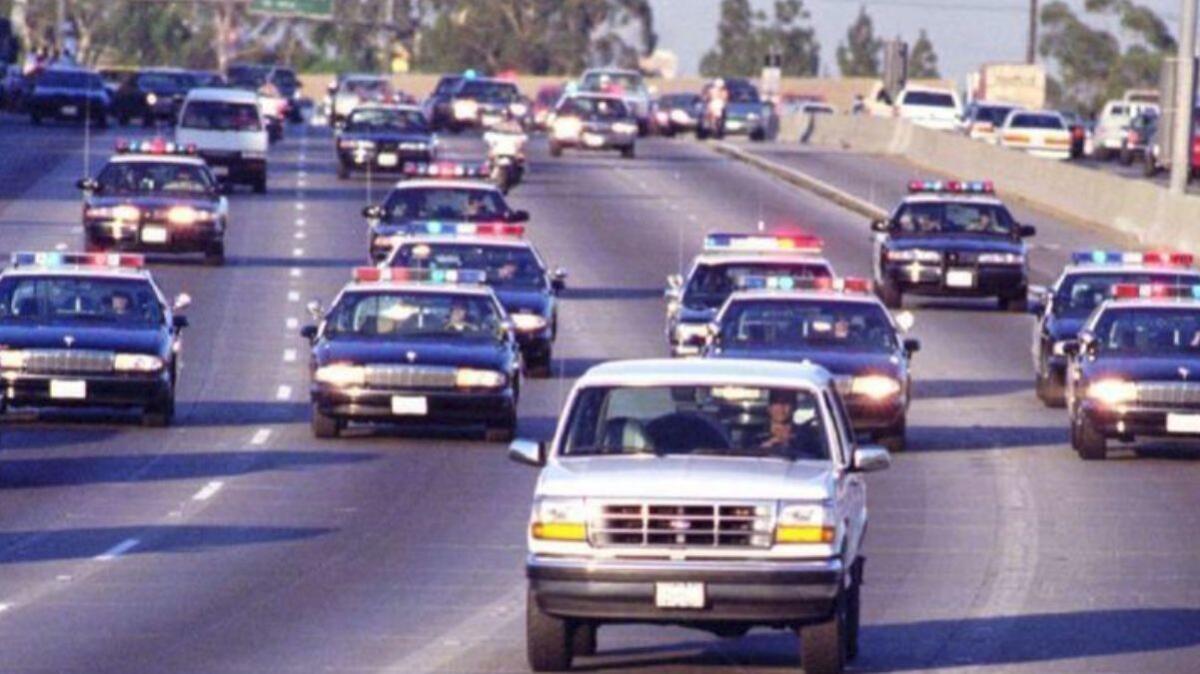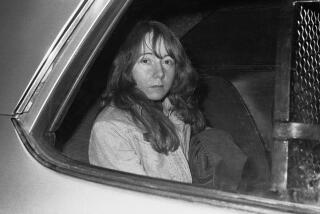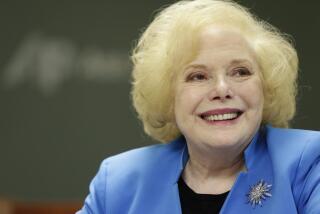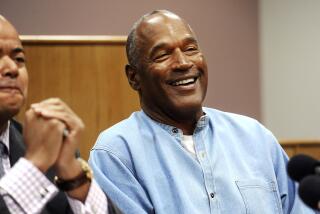TV news chopper spotted O.J. Simpson’s white Bronco, and the chase was on

O.J. Simpson was a fugitive, and it seemed the whole world was looking for him.
It was June 17, 1994, and Simpson was supposed to turn himself in to Los Angeles police in connection with the killing of his ex-wife, Nicole Brown Simpson, and her friend Ron Goldman.
Zoey Tur was piloting a helicopter for KCBS-TV and had a hunch: Maybe Simpson had gone to Orange County to visit Nicole’s grave. So she flew in that direction, and she would be the first to start broadcasting the most famous police pursuit in history.
Within minutes, the world was transfixed by what it was seeing. Tur said that even in the moment, she knew this was history in the making.
TIMELINE: How the O.J. Simpson white Bronco case unfolded
She’d covered the L.A. riots, fires and other major stories. But this was different.
“Sitting up there, the enormity of it hit you. He is one of the most famous people in America and he is running from the police as a wanted murderer,” Tur said.
“It was a like serene parade with O.J. leading the procession.”
‘We’ve got him’
In the days before the chase, Simpson had become the chief suspect in the double murder. He was set to turn himself at Los Angeles Police Department headquarters, and that was the story Tur expected to be telling.
As minutes passed, tension grew, with hundreds of reporters gathered for the perp walk. Finally, LAPD Cmdr. Dave Gascon publicly declared Simpson was a fugitive.
The search began. California Highway Patrol officers finally spotted Simpson on the 5 Freeway in Orange County. He was in the back seat of his friend Al Cowlings’ Ford Bronco, sobbing and holding a gun.
Tur was already in the area, driven by her hunch. Her CBS colleagues heard that the FBI had triangulated Simpson’s cellphone and found he was at the El Toro Y interchange in Irvine.
“So I glanced down and spotted the Bronco with police cruisers on its tail. I screamed to the station, ‘We’ve got him,’ and began the broadcast,” she recalled.
RELATED: Kim Goldman’s crusade: Make O.J. Simpson pay and never forget
The crystal blue sky over Orange County soon filled with a parade of choppers. “The sky looked like something out of ‘Apocalypse Now,’ ” Tur said.
O.J. Simpson: ‘Life is fine’ 25 years after notorious murder case »
With Simpson holding the barrel of a .357 magnum to his head in the back of the Bronco as Cowlings drove north on the 405 Freeway, the networks interrupted regularly scheduled programming to air the pursuit. NBC cut between it and Game 5 of the NBA Finals between the New York Knicks and the Houston Rockets.
Gascon, the LAPD’s chief spokesman at the time, at the center of the media circus, said in an interview last week that “the size of the audience really hit home. My sister in Paris saw me on TV and [so did] my cousin in Shanghai.”
He watched the scene unfold and thought, “What must the world think about those Americans?”
‘A strange, carnival-like atmosphere’
As the chase moved into Los Angeles, the scene became more surreal.
Onlookers jammed the overpasses for a glimpse. Some held up huge signs encouraging the star with messages such as “Go O.J.” As the white Bronco got into Los Angeles, people walked onto the freeway to cheer him on.
It was “a strange, carnival-like atmosphere,” said Tur, who at the time was known as Bob Tur. (She later had gender reassignment surgery.)
At LAPD headquarters, officials debated how the pursuit would end and how they could get Simpson to surrender peacefully.
FROM THE ARCHIVES: The 1994 Times story on O.J. Simpson case
Inside the Bronco, Simpson answered a cellphone call from lead Det. Tom Lange.
With the sounds of sirens in the background, Lange tried to make a connection: “O.J. O.J. This is Tom Lange from the Police Department. Remember me.”
Lange’s goal was to get Simpson to toss the gun out the window.
Gascon said he stood behind Lange as he spoke.
“Just let me get to the house,” Simpson begged the detective.
Lange agreed.
“I just need to get to my house where I lived with Nicole,” Simpson pleaded.
Lange asked him to toss the gun, and Simpson replied, “I am not going to hurt anybody … but I need it for me.”
Lange then told Simpson his kids needed him and his mother loved him.
Kim Goldman’s crusade: Make O.J. Simpson pay and never forget »
Gascon said he thought at the time that Simpson was too much of narcissist to harm himself.
“I thought it was a play for sympathy by Simpson,” he said.
Gascon said the LAPD was prepared with tactical, heavily armed officers at Simpson’s Rockingham estate in case the pursuit ended with a violent standoff and “it went sideways.”
Tur’s chopper was running out of gas, so she had to make a pit stop at Hawthorne Municipal Airport.
Her colleague, Lawrence Welk III, asked for jet fuel. The woman at the airport could not understand why Welk — who she assumed was the famous orchestra leader — wanted the fuel. He explained he was the bandleader’s grandson and they were televising the O.J. chase, Tur recalls.
“You better get back up there, we are watching,” the woman replied.
Tur was overhead when the white Bronco weaved through throngs of spectators and pulled into Simpson’s estate, where he surrendered to police.
“It wasn’t the first pursuit I covered or the last,” she said, “but it was the most memorable.”
More to Read
Sign up for Essential California
The most important California stories and recommendations in your inbox every morning.
You may occasionally receive promotional content from the Los Angeles Times.











